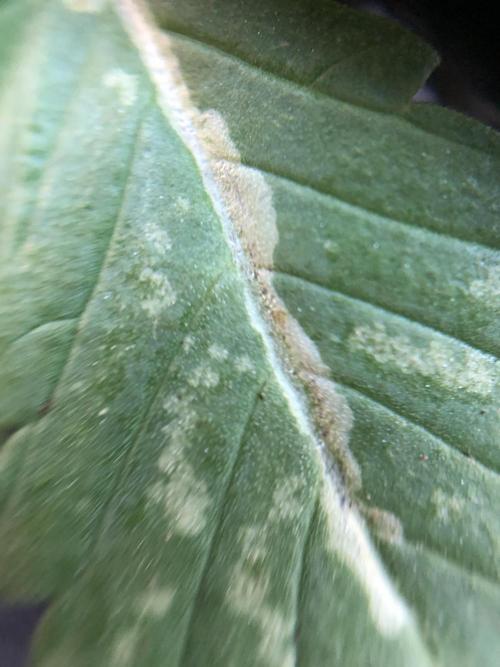The Grow Awards 2026 🏆 






























Why is new growth looking like this?
CloudBlowerstarted grow question 10mo ago
Why is new growth looking like this?
Open
Leaves. Color - Pale
likes
Answer
m0useanswered grow question 10mo ago
I find my new growth can come in a bit weird but will normalize out in a day or so. If it long terms going to need to do some more digging. I think numbers has a good idea of whats happening. Some of the older groth looks lush want to watch how much N its getting.
likes
Complain
Still_Smoqanswered grow question 10mo ago
Well I think 001100 covered everything. I’ll always say check your PH first because it matters more than anything when trying to apply corrections. Then again I grow DWC.
likes
Complain
00110001001001111Oanswered grow question 10mo ago
More than a few things can caust chlorosis in new growth, which is what i see here. So, there's not "1" answer for you at this point. If you recently switched to a bro-science or instructed "flower" formula, it's likely too much P or K. This would cause skinny new growth (fingers) and chlrosis on new growth - so, definitely possible.
Too little S is another option, but should be able to eliminate that by cross-referencing symptoms. Is the bottom of the apical meristem (trunk) 'corky?' Are there red or purple streaks in the stems (!! Not leaf petioles, stems only)? Also the chlorosis would progress inside out which is odd and would stand out, so i doubt it is low S.
Some trace elements can cause chlorosis in new growth, but if your fertilizer is worth anything, should have all of this. Which leaves pH. IF pH is too far off from 5.8-6.2, more so on low side, you'll run into some lockout, but this would usually impact Ca first and higher chance of a smorgasborg of symptoms because pH balance will at some point affect multiple nutrients. Easy to rule out, like S.
I'd let this progress a bit more, as long as it is a slow progression. Be certain of what the symptoms tell you.
for vege i'd suggest somethign like
120-130 N
40-60 P
180ish K
100+ Ca
75-80 Mg
100-110 S
This would be a fairly low concentration overall but well-balanced as far as resulting availability for the plant to grab and use. In flower, drop N to 90-100. Might need to drop down near 1.2ec late flower if darkness creeps in. But, any symptom you see will be rare and slow-moving with easily diagnosed symptoms and minimal adjustments needed to get it right. Overall concentration will be more a function of VPD and other local variables, but the ratios of nutes is solid.
Your tap water may cause a few deviations. However, when i switched from 300ppm hard water to softened water, I didn't have to change anything, fwiw. This isn't 'my' formula. It is one used by many professional AG companies that sell a 'hydro' system of nutrients -- ~3 parts should be sufficient.
religious 10% runoff waste water is absolutely integral to a soilless grow running flawlessly. if neglecting that, it could be the cause of what you see.
fertilizing isn't about what you did yesterday or even last week. It's the culmination of your behaviour since that plant has inhabited that pot. giving too much or too little can sometimes take months to show itself. Despite common belief, plants are not significantly more picky in bloom. More often problems seen in flower are due to poor fertilization habits in vege phase, but that would mean taking accountability for a problem rather than blaming it on extrernal sources, which most egos will not allow. It ain't foie gras. You can't force a square peg through a round hole where L=D. Goldilocks zone is what you want.. not more, more more.
----------
Mg deficiency is interveinal chlorosis with rusty necrotic spots. I don't see this hear, also it would normally start mid or lower plant because it's at least partially mobile. I don't see this. Calcium deficiency is just spots, and i don't see that. Adding calcium or magnesium probably won't improve anything.
Coco does not require more calcium than other soilless substrates that should be devoid of nutrients or simply not impact them in the case of 'good' coco coir. It does not change any biological process in the plant, therefore the same levels of Ca will work with coco as anything else. The pitfall with coco is that it requires buffering not to initially leach cations (like Ca++) from your fertilizer. Even so, this is a temporary thing and will eventualyl reach an equilibrium where nothing is lost or gained as far as interaction with fertilizer. Not something you want to power through. It;s one of the dangers few speak about when dealing with coco. Unprocessed coco can kill plants very easily with Na+ or releasing a shit ton of K because it wasn't properly buffered for use with plants.
I've never had to change my formual as i switched from sphagnum peat moss base to coco coir and back to sphagnum peat moss. the only thing that differes is the amount of perlite or similar you should add, because coco coir retains less water by comparison (33% perlite vs 50% in sphagnum peat moss).
100-120ppm of Ca should be plenty as part of a well-balanced 1.3-1.5EC fertilizer. If providing roughly that and having issues, it's a sign that you are too high in something else that can inhibit Calcium uptake or use in the plant. How much you tap water adds may influence the exact amount you need to add.
soilless requires 100% of nutritional needs at all times. You'll need to drop N fairly early in flower and reduce overall concentration mid-to-late flower, but otherwise a good consistent formula will be fine. Religiously get 10% runoff to ensure no buildup of nutes occur. this eliminates one possibility each time you see a problem -- it will never be buildup but rather simply feeding too much of one thing in your formula.. it won't build up in the substrate but it can be over-provided. Flushing should never be required except for utter catastrophe.
2 likes
Complain
Aldo90answered grow question 10mo ago
Up the feed mate. Sensi coco has enough calmag in to cover most of the time. Especially at your stage. But your using very little going off the dairy. I start on 2ml per litre in coco.
likes
Complain
Organomananswered grow question 10mo ago
Magnesium deficiency.
Add some cal/mag to your fertilizer line up or increase the doage if already using one.
Symptoms will take 10-14 days before they disappear.............new growth should be ok if you add/increase the cal/mag.
When growing in coco coir, you need to use extra cal/mag from virtually day one.
likes
Complain
Similar Grow Questions
Solved

GrowmieDeLaStreet
Brown edges on young plantI left a dome on and didn't let it breathe for 3 days. It's been a week and it keeps getting worse.
Using Promix potting mix and I fed her only once at the start of her 2nd week of veg: 6.5pH-412ppm-20,8°C
Humidity: 55%RH Temp: 82°F Light distance 24'' and good air circulation.
Leaves. Edges burnt
Leaves. Color - Pale
4y ago
3
Solved

CRimp
nutrient deficiency ?What do you Guys this Lady is missing out on ? Look likes she missing out on somethink in her diet i gues
Week 4
Leaves. Color - Pale
6y ago
3
6
Solved

Raidoiu
Problema di PeppaBuonasera ho bisogno di aiuto. non so cosa sia successo in 4 giorni, le altre stanno benissimo lei no.Sono stato attentissimo ai macro e a tutto ciò che necessitavano.... Sono stato via 4 giorni l'unico valore che è uscito fuori norma è la temperatura 28.5. Help me!
6y ago
3
1
Solved

ItalianDesertBalcony
Is this a symptom of spider mites or something else?Is this symptom caused by spider mites also, or is this a different issue? There is pale green/loss of color along the veins of two leaves. I’m aware of my spider mite problem, but want to know if there is another issue or just more symptoms of the mites.
Leaves. Veins - yellow between
Leaves. Color - Pale
Leaves. Color - Mottling
3mo ago
4
Solved

MakeMeSleepy420
New growth is light green? (1st grow)New growth is light green – seems like Nitrogen deficiency or maybe light-burn? It's been getting slowly worse. Water ph is 6.7, Fox Farms nutes, AC Infinity 4x2 w/ 200w lights @ 18" on 80% power.
Leaves. Curl down
Leaves. Color - Pale
Other. General questions
2y ago
2
5
Solved

supermegadjj
New growth twisted, pale green. Lady luck auto week 4. Temp 24c Rh 50Hi guys I've got lady luck from penthouse seeds in 4th week in soil with perlite and Coco. Mars ta600 hanging at least 24 inches away. I feed megacrop last time was 0.5g per l (half dose ). 2 days ago she got ph water. New growth twisted, deformed and really light green.Whats up?
Leaves. Twisted
Leaves. Color - Pale
Feeding. Deficiences
5y ago
2
Solved

dannitay
Possible Nutrient issues with 1 week old baby plantNewbie grower having a possible problem with a new plant. Plant is 1 week old and is developing what I think is maybe a nutrient deficiency. I just started Dakine 420 nutes I am growing three plants total but only once is showing possible issues. Any suggestions are welcome.
Leaves. Color - Pale
5y ago
1
2
Solved

Magiksoul
What is this problem? I cant figure it out plz help meWhat is this problem? I cant figure it out plz help me! I used a mix of soil BioBizz all mix with coco and some perlite! Im at the begining of the 4th week! And i been watering with bottle water and used one time the plagron nutes for roots and lastly used once th backtomatik rex
Leaves. Tips - Die
Leaves. Color - Pale
4y ago
1
5
Solved

HughWick
Nutrients burn?So these spots showed up all over my girls over night, i fed them a little over double the amount of nutrients that i had last week ( 15ml Nut/ 4L water) which i'm thinking may have been my mistake. Should i be worried? Anything i should do?
Week 4
Leaves. Color - Pale
4y ago
2
3
Solved

myketb
How can I recover from nutrient lock and bad pH soil. I never pH my water and found out that my runoff is now pH 7.5. I am not able to lower my soil pH.What else can I do to recover from bad pH watering habit and nutrient lock for my two months old photoperiod. Already flushed the plant, has been about 7 days and it still doesn't seem to look promising. 7 days since flushing I watered with compose tea (700ppm / pH 6.0) once.
Leaves. Curl down
Leaves. Color - Pale
Plant. Wilting
4y ago
8
10
Solved

Ner0z
Seedling diagnosesThese seedling are 10 days old but have slowed in growth and appear droopy. They are in promix hp with perlite 18/4 lighting roughly 76 degrees 55-60% rh. Watering daily @6.1 ph 220ppm due to the heaters drying the mediumand cardboard containers. Don't think its overwater but idk
Leaves. Curl down
Leaves. Color - Pale
Plant. Wilting
5y ago
4
5
Solved

DoDrugs420
Why is plant GC1 & SG1 so far behind in relation to GC2 & SG2 and GC3 & SG3, can anyone provide any info on this? Stunt growth since about day 7 or 8, never grew a mm since then, same environment and care as the other 2 but just being weird. Thanks in advance for info. 2 diaries5y ago
1
1
Solved

Thalps
sad lookin leaves coming to the end of the first growhi guys, snapped a couple photos of this while I was checkin on the plant this morning but I cant tell whether the plant is being burnt by the lights or its deficient in something, the affected area is 99% in the top leaves however a couple of lower ones are also looking sad.
5y ago
4
Solved

MrMrsJamillio
Nut defiencey?I'm still at a loss as too what's happening to my paradise plants they are about 7wk old clones
Leaves. Color - Pale
5y ago
1
5
Solved

OrionGrowgul
Was hat meine Gorilla Cookies?Helle Stellen auf den Blättern.
Gieße erstmal nur mit angepasstem PH-Wert und Wasser.
Week 8
Leaves. Color - Pale
5mo ago
4
1
Solved

ObserverInterest
Pale upper leaves - what is it?Overnight the top leaves of 2 plants went slightly pale, so assuming not nitro deficiency. Growing in Coco veg week 5. I just upped my light intensity but not much, and I did erroneously flush 2 days ago with pure water but gave a good feeding the next morning with normal nutes
Leaves. Color - Pale
2y ago
1
3













